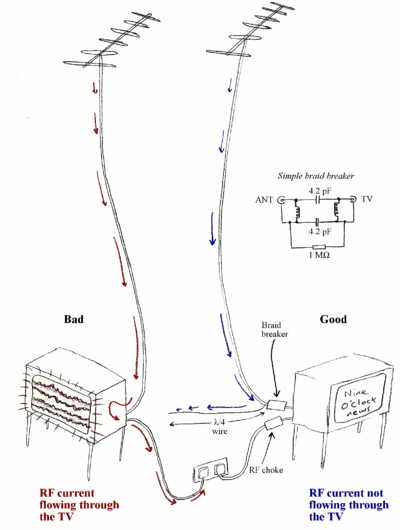Braid-breaker

A braid-breaker is a filter that prevents television interference (TVI). In many cases of TVI, caused by a high field strength of a nearby high frequency (HF) transmitter, the aerial down lead plugged into the back of the TV acts as a longwire antenna or as a simple vertical element. The radio frequency (RF) current flowing through the tuner of the TV tends to generate harmonics which then spoil the viewing.
The braid breaker works by preventing RF signals picked up on the outside (common mode signals) flowing into the TV set, while passing RF inside the coax (non common mode) from the antenna.
Designs
One design is a snap-on ferrite choke, plugged into the aerial cable just before it plugs into the TV set.
Another option is to use a combined braid breaker and high-pass filter. One simple design consists of two 4.7 pF ceramic capacitors and two simple air-core inductor coils (4 turns of 20 AWG copper wire wound using a 6 mm drill bit as a form). The design is a symmetric network: the coils are connected from the braid to the core of the coaxial cables, while the capacitors connect the input and output, one each for the cores and the braids. Finally, a 1.5 MΩ resistor is wired in parallel with the capacitor connecting the shields; this serves to prevent the buildup of static electricity on the TV aerial.
The reactance of the capacitors is very large for signals between 1 and 50 MHz, but for UHF TV signals (>450 MHz) it is very small. Also, the reactance of the coils at the lower frequencies is very small, while for the wanted UHF signals the coils have a very high impedance. The network does the following:
- At HF (1 to circa 50 MHz) it shorts the core to the braid at both the input and the output, while isolating the input from the output.
- At UHF it has no path between the core and the braid for either the input or the output, while the core and the braid are connected as normal to the respective terminals on the other side of the network.
See also
References
- The radio amateur's guide to EMC, Robin Page-Jones (G3JWI), published by the Radio Society of Great Britain, Potters Bar (Hertfordshire), 1992.
- How to Improve Television and Radio Reception - a booklet published by the British Department of Trade and Industry. This booklet is out of print but a copy can be seen at